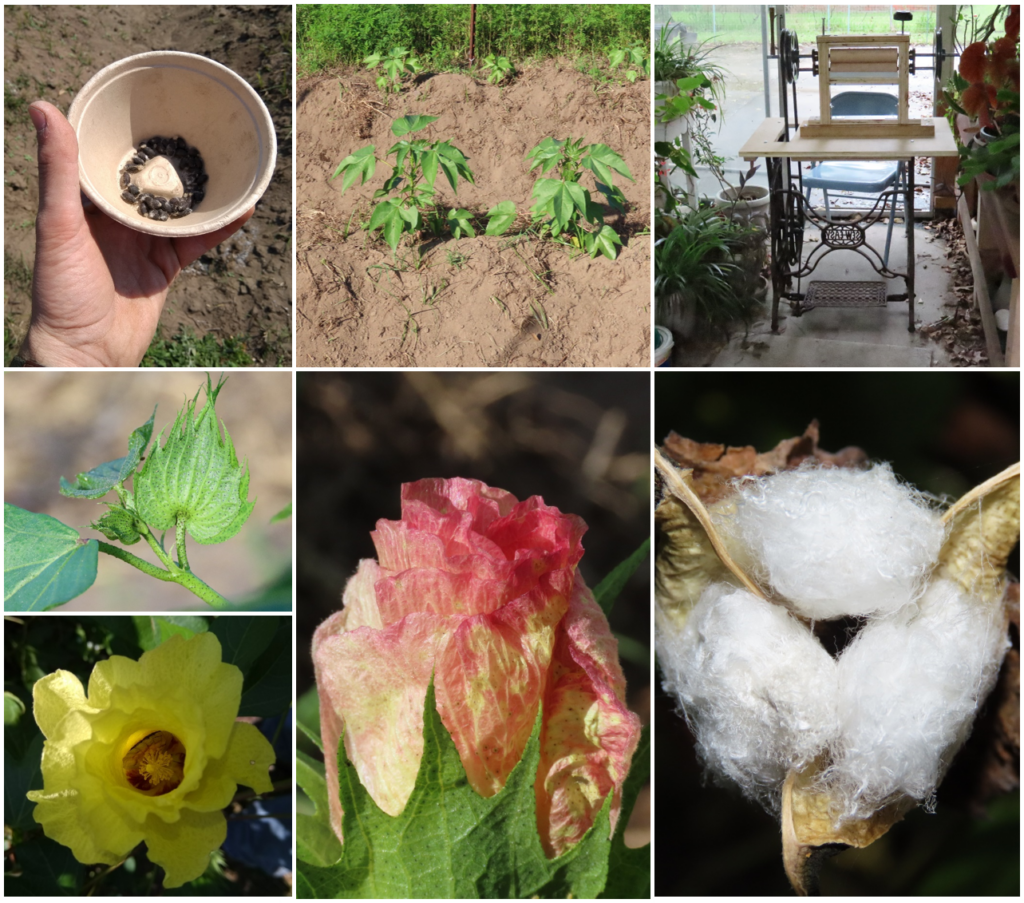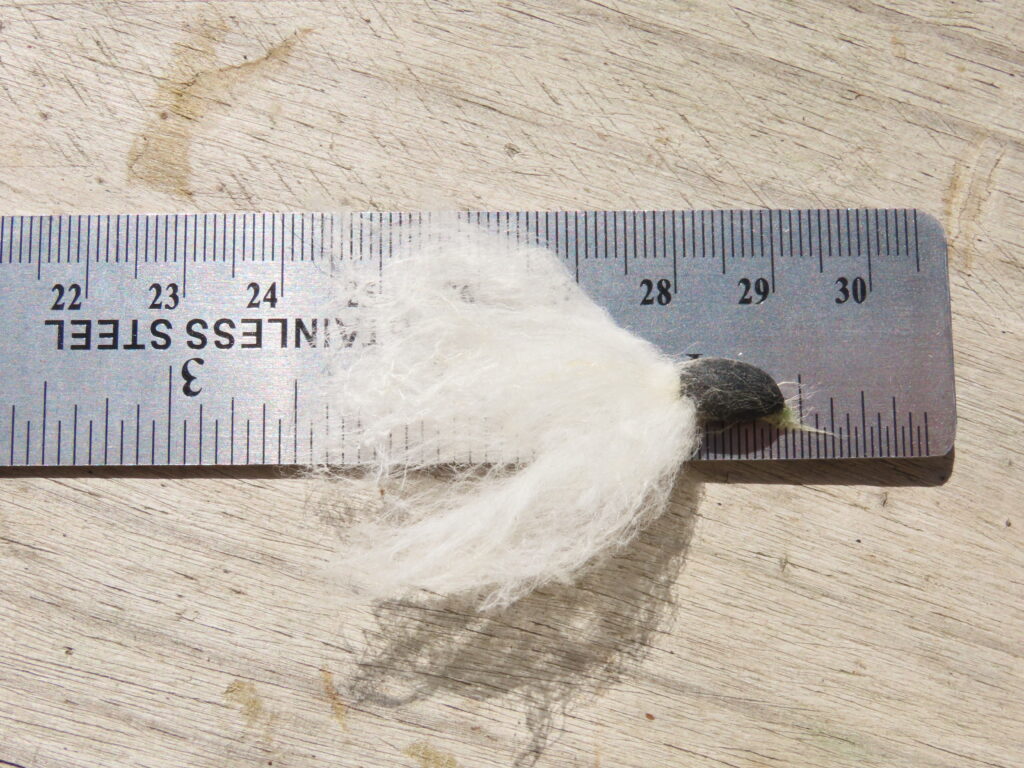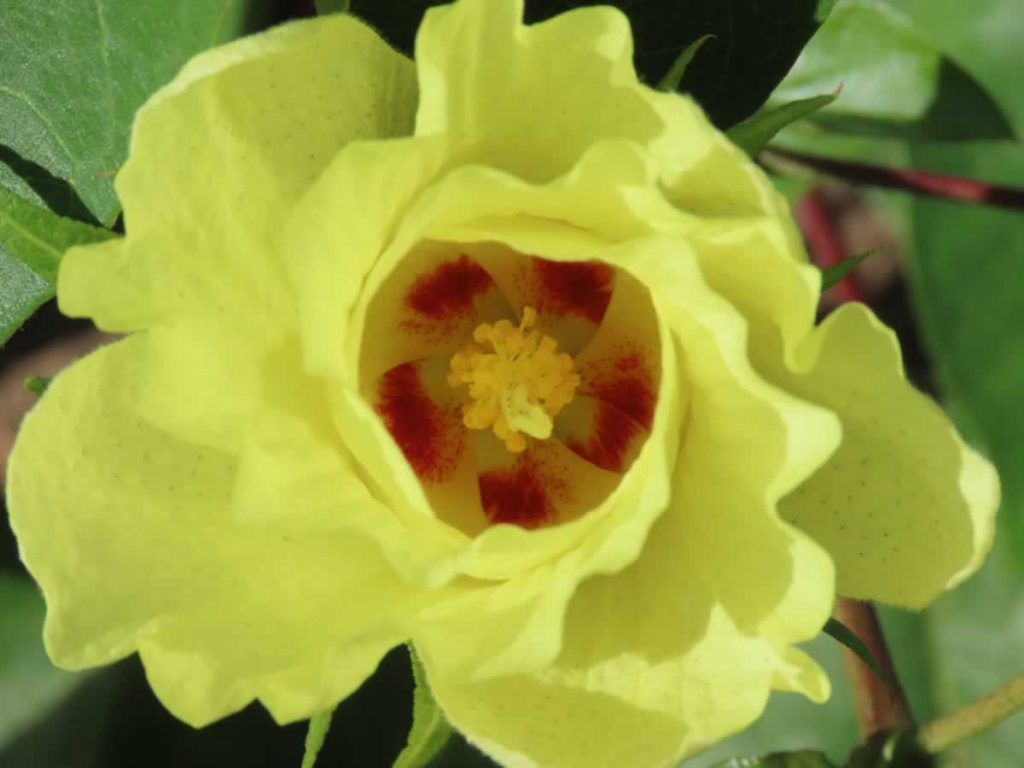As part of both our historical and environmental interpretation of the property, EIOLT maintains a small plot of Sea Island Cotton for demonstration. Henry Hutchinson made his living and based his entrepreneurial business on producing, processing, and selling Sea Island Cotton for the Charleston market. He planted his own lands in cotton and ginned cotton for his neighbors. Henry’s cotton gin was built inside the Clark Manor’s old cotton house, which Henry refurbished. A cotton house was a special two or three story outbuilding on a plantation that housed all of the cotton processing facilities. Here cotton from the field was dried, cleaned, ginned, cleaned again, and then packed in bales to be shipped to market. Henry is believed to have owned and operated a steam-powered McCarthy Gin in his cotton house, an expensive and modern machine for the time that could quickly handle massive amounts of cotton with few laborers. Henry acted as a middleman, handling the processing and shipping of the cotton and distributing the profits accordingly. Our demonstration Sea Island Cotton plot gives us a living exhibit to interpret this important facet of the Hutchinson Family’s history to visitors.

For Henry Hutchinson, Sea Island Cotton was his livelihood. It was the thing that put bread on his table and paid for his children’s education. As such, the story of the Hutchinson House is inseparable from that of Sea Island Cotton.
During its 140 year life as a cash crop, Sea Island Cotton experienced an explosive ascent, a paradigm shift, and a rocky descent into a nosedive from grace. The crop was first developed around 1790 on the Sea Islands of Georgia and South Carolina. Sea Island Cotton was developed from a tropical plant and thrived in the climate of the Lowcountry. Its silky fineness, considerable strength, and impressive length made it a must have raw material for the spinners and weavers who produced for Europe’s aristocracy. Edisto Island and Johns Island quickly found themselves at the epicenter of an explosion of the Southern economy. Planters rushed to buy as many acres of planting land, and enslaved hands, as they could in a rush to produce as much Sea Island Cotton as possible. As the industrial revolution swept over Europe, the demand only grew. Billions were made and millions suffered.
By the mid-1800s, Sea Island Cotton’s profitability had peaked and was beginning to wane and abolitionist sentiments were drawing to a head. The Civil War wrenched the nation in twain. By its close the formerly enslaved now found themselves free men and women in a country wounded with violence and hatred. In this time of turmoil, many returned to what they knew best, farming. Truly, there was little alternative for those who wished to stay on the lands where they were raised. Although some found no solace in toiling the Earth, especially freedmen trapped in the vicious cycle of the sharecropper, others found great prosperity with Sea Island Cotton. Henry Hutchinson was one such man.
Henry planted Sea Island Cotton on the land he inherited from his father and he owned and operated a cotton gin for himself and his neighbors. Henry coordinated the sale of their cotton through his factor, Dill & Ball, and distributed profits and loans accordingly. Henry tended to Sea Island Cotton throughout his life. He worked the lands surrounding his home and bought a better life for his children with it.
In 1918 the Boll Weevil arrived on Edisto Island. It burned through the cotton belt like a fire on a windswept prairie, consuming the harvest and spoiling the land in its wake. By 1920, Sea Island Cotton was a losing venture and by 1940 it was abandoned by all. Here the story of Sea Island Cotton was thought to end. The reign of King Cotton had ended and no heirs claimed the crown. For 75 years the pedigree of Sea Island Cotton was thought to have died out and been lost to time. Reduced to nothing more than a few favorable genes in the Egyptian and Pima cottons. Local botanist Dr. Richard Porcher wrote the book “The Story of Sea Island Cotton” in 2005 and closed the cover on its history.
However in 2015, pure Sea Island Cotton seeds were rediscovered hiding in plain sight. A tellingly named accession was legible online and listed as being maintained in the USDA’s cotton seed vault. It was a cotton listed only as “Bleak Hall Sea Island” and deposited in 1939. Bleak Hall was located just two miles south across Ocella Creek from the Hutchinson House and was a major producer of cotton seed for planters throughout the early 1900s. The chances that Henry Hutchinson grew the same strain of Cotton on his land are considerable. William McLean, a Charleston attorney, stumbled upon this online listing in pursuit of a surviving Sea Island Cotton pedigree. He requested seeds for research and was rewarded with a bounty of 25 seeds. Those 25 seeds grew into 23 plants here on Edisto Island, which yielded promising appearances and plenty of seed. A second generation was grown at McLeod Plantation in partnership with the Charleston County Parks and Recreation Commission the following year.
In 2019, EIOLT received 250 seeds from Mr. McLean from his second generation of plants. Land Protection Specialist, Tom Austin, was charged with the responsibility of designing, maintaining, and researching the plant. He set about preparing a plot of 50 plants that winter. By March 21st, the seeds were planted and they began to germinate within two weeks. Over the course of the growing season, environmental challenges were met and overcome, and from them lessons learned. A month long drought, an outbreak of soil fungus, soil micronutrient deficiencies, an invasion of boll-rot carrying stinkbugs, and a hurricane all sought to claim the crop. Amidst it all, much background research was done, meticulous data was collected, two cotton gins were designed and built, and a meager harvest was made. It was enough to warrant continuing the project. The demonstration Sea Island Cotton plot has continued to grow and develop at the Hutchinson House ever since.

From the start of the project, there was doubt whether this cotton was truly an unhybridized, pure strain of the original Sea Island Cotton from Edisto Island’s Bleak Hall. The appearance of the plants, the length of the staple, and the character of their development all but confirmed that we indeed had a pure strain of Sea Island Cotton. Research into the history of the seed was able to locate supporting documentation in the form of a paper trail linking our plants to the last confirmed plantings of Sea Island Cotton in the United States. The USDA’s Pee Dee Experiment Station in Florence, SC experimented with breeding Boll Weevil resistant Sea Island Cotton until 1939. The station was documented as maintaining a pure strain of Bleak Hall’s Sea Island Cotton for back-crossing with experimental pedigrees. When the research program shifted focus and was relocated in 1939, we suspect these seeds were sent to the seed vault for safe keeping. A hypothesis that is supported by the 1939 receival date in the USDA seed vault’s accession. The original handwritten USDA records on the history of this strain have not yet been relocated. Additionally, a genetic study from 2001, conducted by a team of researchers studying the inter-related genetic diversity of various cotton cultivars, included in their study the very same accession from which our seeds are descended. They found that our cotton was drastically different from Upland Cottons and grouped distinctly apart from all other modern Long-staple Cotton cultivars! Concrete genetic evidence that indicates our Sea Island Cotton plants contain no Upland Cotton DNA and thus predate all modern Long-staple X Upland hybrids, like Egyptian and Pima cottons. EIOLT staff continue to search historical documents for clues into the pedigree of this Sea Island Cotton strain. We are hopefully that future assistance from USDA staff, researchers, and other interested parties will be able to yield even more conclusive evidence as to where this strain of cotton came from and what exactly it is.

So you might be wondering, “What’s so different about Sea Island Cotton from the cotton crops planted across the Midlands of South Carolina and the rest of the Southeast’s cotton belt?” A great many things set the two plants apart. From the fiber characters, to the color of the flower, down to the manner it’s harvested and woven, almost every detail can be distinguished in some way! Sea Island Cotton is a variety of Long-staple Cotton (Gossypium barbadense), a species of cotton native to South America that was eventually bred out of many of its tropical habits to create the Sea Island Cotton of the Lowcountry. Upland Cotton (Gossypium hirsutum) is an entirely different species native to Central America.
The biggest difference between the two species is the length and fineness of the cotton fibers. The fiber is called either the “staple” or the “lint” depending on the context. Upland Cotton has a short, coarse staple that is best utilized for bulk fabrics that don’t require particular strength or fineness. Sea Island Cotton produces a long, fine staple ideal for manufacturing both high strength and exceptionally thin threads, which are best-suited for high-end luxury clothing and specialized engineering applications, such as drive-belts, parachute lines, tire radials, and aviation stitching. Some strains of Sea Island Cotton were able to produce a staple double the length of modern Upland Cottons! Another major difference between the two are the climatic and environmental requirements they need to be productive. Upland Cotton grows and yields well on a wide variety of soils. It matures quickly and produces a considerable yield in a short period of time. Sea Island Cotton is pickier about where it grows and takes longer to mature. It does best on the sandy, well-drained soils of the coastal plain. Its more tropical nature means it benefits greatly from the long growing season and hot, humid climate of the Lowcountry. The Sea Islands of South Carolina are a perfect nexus between these necessary growing conditions.
Another major difference between the two cottons is in the way the lint is attached to the seed and, as a consequence, the manner they must be processed. Upland Cotton is also known as Greenseed Cotton because of its small, hairy, greenish seed. In Upland Cotton, the seed is soft, small, and coated all over its surface in lint. Long-staple Cotton is also known as Blackseed Cotton due to its large, smooth, shiny-black seed. In Sea Island Cotton the seed is hard, large, and with lint originating only from the tips and along the seam of the seed. This relative hairiness makes Upland Cotton difficult to gin. Ginning is the processes of removing the lint from the seed. It is an essential step before the fiber can be processed into thread and cloth. The Churkha cotton gin was first invented in India nearly a millennia ago and was used to gin various old-world cotton species. Before its invention, ginning was done either by pulling out seeds by hand or with a dowel rolled on top of a flat stone. The Churkha was the first roller cotton gin and its design was extensively modified and improved in the Caribbean and colonial United States to process plantation grown Long-staple Cotton. The long fibers and large, smooth seeds of Long-staple cottons made it easy to gin on these simple roller designs. The seed cotton was fed in-between the counter-rotating rollers of the gin where the lint was pinched and pulled away from the seed until it dropped away free and only ginned cotton came out the back. The soft, hairy seeds of Upland Cotton crushed easily and separated with great difficulty from the lint, making the crop nigh impossible to gin on a roller design. In 1792, Eli Whitney patented the saw gin. A gin designed with hooked teeth on a roller that rotated through a slotted comb to rip lint off of the seed. Whitney’s saw gin made Upland Cotton economically viable and created a market for the bulk fiber it produced. The saw gin was incredibly rough on the staple, something that the coarse, short lint of Upland Cotton could endure. However, the saw gin ripped apart the long, silky fibers of Sea Island Cotton, greatly reducing its market value. Thus, Sea Island Cotton must be ginned on a roller gin design to preserve the length and strength of its lint for the specialty textiles it is made into. Because of this requirement, Tom Austin had to design and construct two styles of double-roller cotton gin to process the Sea Island Cotton grown at the Hutchinson House.
There are other obvious differences in the morphology, or shape, of the plants themselves that can help distinguish the two species. Upland Cotton is a shorter plant, usually staying under five feet in height. By comparison, Sea Island Cotton can exceed eight feet in height in a season! The leaves of Upland Cotton are mostly three-lobed with squared-off shoulders, while the leaves of Sea Island Cotton can have up to seven lobes with a more rounded, hand-like shape. Upland Cotton produces a cream-white or pink flower and Sea Island Cotton blooms with a strong pastel-yellow that ages to peach and then pink. The boll, which is the name for the cotton fruit within which the seeds mature, is round like a ping-pong ball in Upland Cotton and shaped like a pointed egg in Sea Island Cotton. The lint of Upland Cotton is predominantly snow-white and matte while the fibers of Sea Island Cotton are faintly glossy with an eggshell hue. Upland Cotton often produces far more lint per boll than Sea Island Cotton and the locks of Upland Cotton are far easier to remove from the bolls.
One other difference that emerged in the twentieth-century is how well each plant adapted to the mechanization of farming practices and the global market. Sea Island Cotton largely fell out of cultivation due to its long fibers being far more susceptible to damage by the Boll Weevil. The Boll Weevil was a small species of beetle native to Mexico that laid its eggs on the cotton fruit and whose larvae fed on the fibers inside. The Boll Weevil’s arrival in the Lowcountry decimated both the Sea Island Cotton and Upland Cotton crops. However, Upland Cotton was naturally adapted to the weevil and its market was far more stable. So it was able to weather the pest’s onslaught. However, the Sea Island Cotton market evaporated under the pressure of the Boll Weevil. By the middle of the century, mechanized pickers were able to harvest the cotton from the plants without the need for laborers, who were in short supply, to perform the tedious and mind-numbing work in the sweltering southern heat. The compact plants and overflowing bolls of Upland Cotton made them well suited for mechanized picking. The towering stalks and tightly packed bolls of Sea Island Cotton necessitated hand picking. The favorable position for mechanization of Upland Cotton sealed the coffin on the economic viability of Sea Island Cotton. Rapidly evolving textile technologies and Egyptian Cotton were able to close the market gap left by Sea Island Cotton. (Nowadays, modern synthetic fibers and genetically fine-tuned Pima Cotton hybrids have cornered the engineering and luxury markets for textiles.) Eventually, the USDA was successful in quarantining and exterminating the Boll Weevil from the Southeastern United States. Upland Cotton has become incredibly cheap to produce and now reigns as the preferred clothing fabric globally.
Written by: Tom Austin, Land Protection Specialist

Then check out the below presentation by Tom Austin on the project!